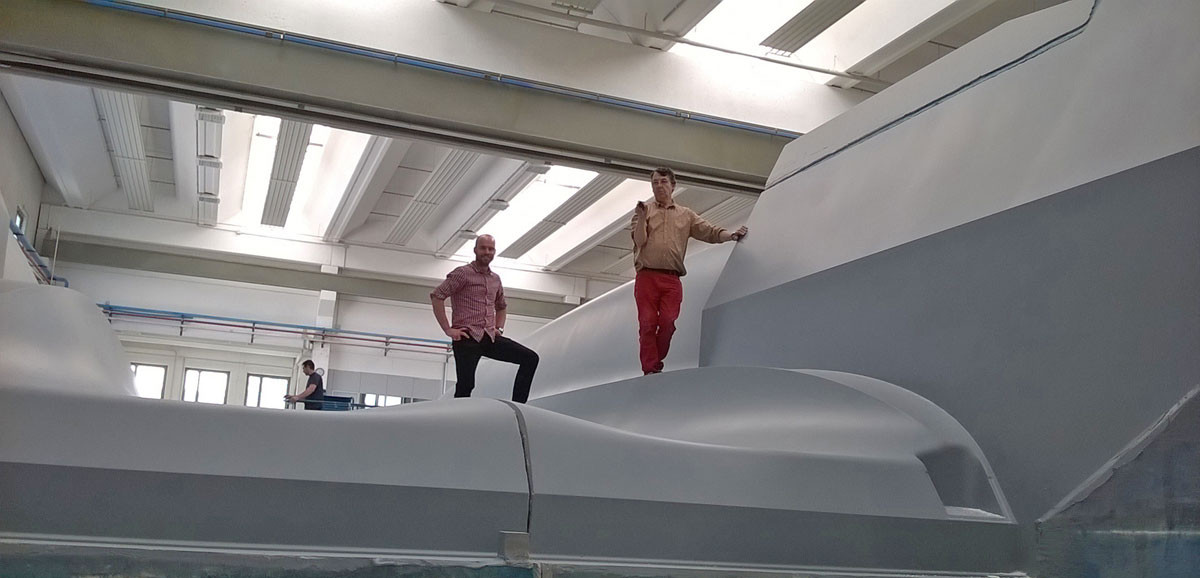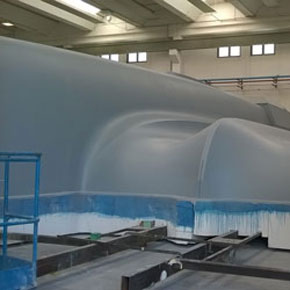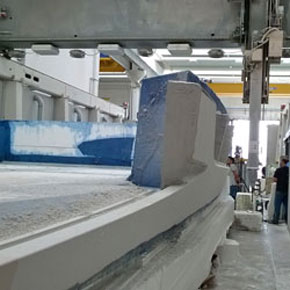 We asked Romain Moses, the method engineer of the SEVENTY 7, to explain us this step :
We asked Romain Moses, the method engineer of the SEVENTY 7, to explain us this step :
The first of the crucial main stages in building a boat is the manufacture of the preforms. A preform is an item that will enable the manufacture of a hull, deck or coachroof mould for example, to ultimately produce a boat that is faithful to the design produced by the architects and product development.
 The manufacture of preforms The VPLP naval architecture firm designs hulls, deck, coachroof and bimini shape. Lagoon takes these drawings, as well as 3D models, and reworks them to incorporate the fittings and mechanical systems such as companionway doors, hull doors, tenderlift, hydraulic gangway, as well as engine peripherals such as plant compartments ventilation, exhaust, shaftline, etc. The design office finally produces a finalised 3D drawing (known as a digital model).
The manufacture of preforms The VPLP naval architecture firm designs hulls, deck, coachroof and bimini shape. Lagoon takes these drawings, as well as 3D models, and reworks them to incorporate the fittings and mechanical systems such as companionway doors, hull doors, tenderlift, hydraulic gangway, as well as engine peripherals such as plant compartments ventilation, exhaust, shaftline, etc. The design office finally produces a finalised 3D drawing (known as a digital model).
From this digital data, we can commence production of preforms and then moulds. We have made moulds for the hull, deck, coachroof and bimini, as well as for a multitude of benches, exterior furniture, hatches, and even interior shower trays.
Example of construction: the hull preform
On the basis of the 3D drawing of the hull, the subcontractor chosen by Lagoon assembles massive polystyrene blocks. A numerically controlled machine will then machine a true full-scale hull, sometimes in several separate pieces due to the size of the final hull (for example, the SEVENTY 7 hull preform was machined in four separate sections). The section is then covered with polyester putty that hardens, it is machined again, the sections are assembled, and the result is the preform.
The Lagoon team will then check the overall shape on the subcontractor’s premises and check the dimensions, the positions of holes for the portholes, apertures, etc.
The preform is then coated with a black lacquer and then meticulously buffed by hand to increase the gloss of the lacquer until a mirror-finish is attained. This is the polished preform. From this, mould production can commence.
What is a methods engineer?
The person responsible for the production engineering of the project, his primary role is to ensure the communication of information between the design office and production.
His tasks are organised chronologically in respect of a project:
At the design stage, he is there to give the design office the benefit of the experience gained on previous projects in terms of production engineering (feedback of experience makes it possible to know what has or has not worked and to capitalise on successes in designing the new boat).
He assists the project manager and the designers in the design office to find technical solutions in order to achieve the desired quality level within a controlled framework in terms of production hours.
He coordinates the design and production of the various tools required to build the boat, such as the composite moulds, access and working gangways, as well as various handling systems. The operators’ safety and work ergonomics require very great attention to these aspects.
In the design phase, he provides information to the shop manager in terms of scheduling and volume of resources required, enabling him to scale his team of operators for the boat going into production.
In the production phase, the methods engineer moves around the production facility in order to be as close as possible to the work on the first boats and to communicate to production all the information acquired during the design phase. Accompanied by the methods team (5 to 7 people), he will present the design office data in such a way as to make it usable by production. He works closely with the shop manager.
Supported by the design office, he helps production resolve any issues encountered in order to maintain feedback, optimising production timescales.
This is a cross-disciplinary job that changes a lot depending on the progress of the project and enables the boat project to be followed from start to finish.




